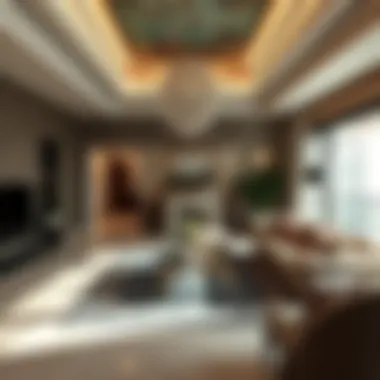Converting 140000 USD to AED: Key Insights


Intro
Currency conversion is not just a calculation; it's a gateway into the vast landscape of global finance. A conversion of 140,000 USD to AED holds significant implications, whether one is planning to invest in Dubai’s real estate, moving to the UAE for work, or simply managing international funds. Understanding how the exchange process works is crucial for both expatriates and investors. Key factors such as the fluctuating exchange rates, economic indicators, and regional developments ripple through the conversion process, ultimately impacting financial decisions.
Market Trends
Current Property Prices
The property market in Dubai has always intrigued investors due to its vibrant growth and potential returns. Recent years have seen fluctuations in property prices influenced by various economic factors. Currently, the market is experiencing a mix of high-end luxury developments alongside more affordable housing options. Prices in areas like Downtown Dubai or the Palm Jumeirah can soar while emerging neighborhoods like Dubai Marina or Jumeirah Village Circle (JVC) offer more accessible pricing. For instance, a two-bedroom apartment in Dubai Marina may set you back around 1.5 million AED, whereas similar properties in JVC might be priced closer to 800,000 AED.
Emerging Areas for Investment
Investors are shifting their gaze towards up-and-coming districts that promise substantial growth. Locations such as Dubai South and Dubai Creek Harbour are gaining traction due to ongoing infrastructure projects and favorable government policies. This makes them ideal for those looking to capitalize on future appreciation in value.
Some other factors worth considering when evaluating these areas include:
- Accessibility: Thoroughfares and public transport can drastically affect property values.
- Amenities: Proximity to schools, malls, and parks makes a significant difference to both buyers and renters.
- Regulatory Incentives: The UAE’s government has implemented various initiatives to attract foreign investment, including relaxed visa regulations for property buyers.
Living in Dubai
Cultural Insights for Expats


Moving to Dubai can be like diving into an ocean of culture. The city is a melting pot of diverse traditions, offering a unique blend of modernity and heritage. Understanding cultural nuances is essential for expatriates. Local customs and etiquettes, such as modest dressing and respect for different religious practices, should be adhered to. Such knowledge goes a long way in building relationships and enhancing the living experience.
Amenities and Lifestyle Features
Dubai offers a lifestyle that is nothing short of extraordinary. The city boasts world-class amenities, making it one of the best places to live. From extravagant malls and luxurious hotels to expansive parks and beaches, residents can find almost any leisure activity they desire. The vibrant nightlife and various culinary experiences reflect the globalized nature of Dubai, ensuring that there’s always something new to explore.
Overall, understanding the nuances of converting 140,000 USD to AED isn't merely about numbers; it involves grasping the socio-economic backdrop that shapes the financial decisions of individuals in Dubai. Whether you're an investor hoping to navigate the property scene or an expatriate looking to settle in, a comprehensive understanding of these aspects can set the stage for a fruitful and enriching experience.
Preamble to Currency Conversion
Currency conversion is not just a financial transaction; it plays a critical role in the global economy and the personal finances of individuals, especially for those involved in international trade or living abroad. Understanding how to convert 140,000 USD to AED, for instance, involves grasping the nuances of exchange rates and what they mean for purchasing power. This section explores the relevance of currency conversion, particularly focusing on the factors affecting USD to AED conversion.
Understanding Currency Exchange
When we talk about currency exchange, we refer to the process of replacing one currency for another. For investors, homebuyers, expatriates, and brokers, this process can make or break a deal. The exchange rate indicates how much of one currency you need to spend to buy a unit of another currency. Essentially, it reflects the value of money in terms of its purchasing power. The USD is one of the most widely used currencies globally, while the AED has specific significance in the Middle East, functioning as the backbone for the economy in the United Arab Emirates.
To illustrate, if the exchange rate stands at 3.67 AED for 1 USD, converting 140,000 USD would yield approximately 514,800 AED. However, this is not as straightforward as it seems. Exchange rates are influenced by numerous factors including monetary policies, international trade balance, and geopolitical tensions. An old adage rings true: "If it sounds too good to be true, it probably is." You must tread lightly, as conversion rates can fluctuate, making it essential to stay updated on current trends.
Importance of Conversion Rates
Conversion rates serve as a barometer of economic stability. For investors and expatriates, knowing the current conversion rate is key. Being off by even a few cents can lead to significant financial implications. For instance, consider an expatriate earning dollars but living in Dubai–the state of the exchange rate helps determine how much of their hard-earned income enables them to live comfortably or invest in properties.
Here are several reasons why conversion rates matter:


- Investment Decisions: The conversion rate can influence where to put your money.
- Budgeting: Knowing the right rates helps budget effectively, especially for expats.
- Real Estate Ventures: A favorable rate can benefit investors seeking properties in Dubai.
- Financial Transactions: Businesses engaging in international transactions must pay attention to these rates to avoid losses.
"In the world of finance, knowledge is power. Being informed can save you thousands."
In summary, understanding the landscape of currency conversion is foundational for anyone engaged in financial activities across borders. By grasping the essentials like the importance of exchange rates and the intricacies of currency exchange, individuals can navigate the complex web of international finance with greater confidence.
The Current Exchange Rate Dynamics
Understanding the current exchange rate dynamics is fundamental to grasping the intricacies of converting 140,000 USD to AED. In an ever-fluctuating financial landscape, where various factors influence currency values, being aware of these dynamics isn't just helpful; it's essential. Currency exchange rates are not just numbers; they represent the economic health and sentiments governing trade between the United States and the United Arab Emirates. Thus, being cognizant of what drives these rates can significantly impact decision-making for investors and expatriates alike.
Factors Influencing Exchange Rates
Currency values are like a seesaw, dipping and rising based on numerous interconnected factors. Understanding these aspects will equip stakeholders with the tools to make informed decisions about currency conversion. Here, we dive into some of the main factors at play.
Monetary Policy Impact
Monetary policy serves as a critical driver of exchange rates. It encapsulates the strategies implemented by central banks to control the money supply and influence interest rates. For instance, when the Federal Reserve, the central bank of the United States, opts to increase interest rates, it can attract foreign capital, leading to a stronger USD against the AED. The key characteristic of this factor is its responsiveness; changes in monetary policy can have immediate effects on currency values.
That said, while a strong USD can be advantageous for American investors, it could spell trouble for those looking at purchasing properties abroad. The unique feature of monetary policy is its dual nature—while attractive interest rates might benefit investments, subsequent rapid increases could also lead to volatility. Investors should closely monitor these shifts to mitigate risks when converting USD to AED.
International Trade Dynamics


International trade dynamics are another crucial determinant of currency value. Trade balances between countries shape their exchange rates. If the U.S. exports more to the UAE than it imports, the demand for USD typically leans heavier, therefore strengthening its value compared to AED. A key characteristic of this dynamic is its cyclicality; as trade policies shift or global demand fluctuates, the corresponding impact on exchange rates is often swift.
The unique aspect here is that trade relations can directly influence how both currencies perform relative to one another. Nonetheless, it’s also important to factor in trade tensions, as they can lead to unpredictable repercussions in exchange rates, making this an essential topic for anyone interested in converting substantial amounts like 140,000 USD to AED.
Market Sentiment and Speculation
Market sentiment and speculation are often seen as the emotions behind currency trading. Investors' perceptions of economic conditions can tilt the balance of supply and demand, influencing exchange rates significantly. For instance, if global markets are jittery, investors may flock to the safety of the dollar, further bolstering its value against the AED. The key characteristic here is its unpredictability; market sentiment can change with the wind, given that it's based on news, events, and forecasts.
This factor underscores the psychological components of finance, which can overshadow fundamental economic indicators. One unique feature of market sentiment is that it can create opportunities for those looking to convert currencies at a favorable rate. However, the downside lies in its volatility; swift changes in market perception can lead to sudden price swings in exchange rates. Therefore, understanding the nuances of market sentiment is crucial before engaging in large conversions, like 140,000 USD to AED.
Historical Trends of USD to AED
Historical trends give an enlightening perspective on how the USD has fared against the AED over time. This history can provide better insights into future outcomes. Over the years, the USD and AED have demonstrated various fluctuations driven by countless market forces. Understanding these trends not only helps in making informed predictions but also aids stakeholders in planning effective conversion strategies.
Conversion Process Explained
Understanding the conversion process of 140000 USD to AED reveals its significance for investors, expatriates, and anyone engaging in the global financial arena. Currency conversion is not merely a mathematical exercise; it embodies various factors like market dynamics, time sensitivity, and financial obligations. This section will shed light on crucial aspects such as how amounts are calculated and the tools available to make these conversions seamless. By grasping these elements, readers can maneuver better in Dubai's real estate market, ensuring they make informed financial decisions.
How to Convert Currency
Calculating Equivalent Amount
Calculating the equivalent amount in currency conversion plays a pivotal role in understanding overall financial dealings. When converting 140000 USD to AED, it’s essential to know how this calculation reflects the current exchange rates and how they fluctuate. The primary characteristic of this process involves taking the amount of USD and multiplying it by the current exchange rate between USD and AED.
For instance, if the exchange rate is 3.67 AED for every 1 USD, the conversion will involve:
plaintext 140000 USD * 3.67 AED/USD = 514800 AED







